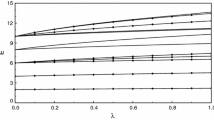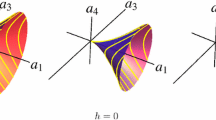Abstract
A practical method for the detailed exploration of two degrees of freedom dynamical systems is presented in this paper. This method is made up of several steps, in each of which we eliminate, via the introduction of suitable action-angle variables, the most relevant harmonic present in the Fourier expansion of the perturbation. In this way, at the end, one obtains a satisfactory description of the fine structure of secondary resonances, as well as detailed information about the size of chaotic layers and about the localization of regions filled up with invariant tori.
Similar content being viewed by others
References
Akima, H.: 1970, ‘A New Method of Interpolation and Smooth Curve Fitting Based on Local Procedures’,Journal of the ACM 17, 589–602.
Arnold, V.I.: 1963, ‘On a Theorem of Liouville Concerning Integrable Problems of Dynamics’,Sib. mathem. zh. 4, 2.
Chirikov, B.V.: 1979,Phys. Reports. 52, 265.
Delaunay, C.: 1867, ‘Theorie du mouvement de la Lune’,Mem. Acad. Sci. Paris 29.
Escande, D.F. and Doveil, F.: 1981,J. Stat. Phys. 26, 257.
Escande, D.F. and Doveil, F.: 1981,Phys. Lett. 83A, 307.
Henrard, J. and Caranicolas, N.D.: 1990, ‘Motion Near the 3/1 Resonance of the Planar Elliptic Restricted Three Body Problem’,Celest. Mech. 47, 99–121.
Henrard, J.: 1990, ‘A Semi-Numerical Perturbation Method for Separable Hamiltonian Systems’,Celest. Mech. 49, 43–67.
Henrard, J. and Moons, M.: 1992, ‘Capture Probabilities for Secondary Resonances’,Icarus, in press.
Moons, M. and Henrard, J.: 1992, ‘Surfaces of Sections in the Miranda-Umbriel 1/3 Inclination Problem’, in preparation.
Malhotra, R. and Dermott, S.F.: 1990, ‘The Role of Secondary Resonances in the Orbitel History of Miranda’,Icarus 85, 440–480.
Morbidelli, A. and Henrard, J.: 1991, ‘The Main Secular Resonancesv 6,v 5 andv 16 in the Asteroid Belt’,Celest. Mech. 51, 169–197.
Morbidelli, A. and Giorgilli, A.: 1993, ‘Quantitative Perturbation Theory by Successive Elimination of Harmonics’,Celest. Mech. 55, 131–149 (this issue).
Poincaré, H.: 1892,Les methodes nouvelles de la mechanique celeste, Gauthier-Villars, Paris.
Tittemore, W.C. and Wisdom, J.: 1989, ‘Tidal Evolution of Uranian Satellites. II: An Explanation of the Anomalously High Orbital Inclination of Miranda’,Icarus 78, 63–89.
Author information
Authors and Affiliations
Rights and permissions
About this article
Cite this article
Morbidelli, A. On the successive elimination of perturbation harmonics. Celestial Mech Dyn Astr 55, 101–130 (1993). https://doi.org/10.1007/BF00692424
Received:
Revised:
Issue Date:
DOI: https://doi.org/10.1007/BF00692424




